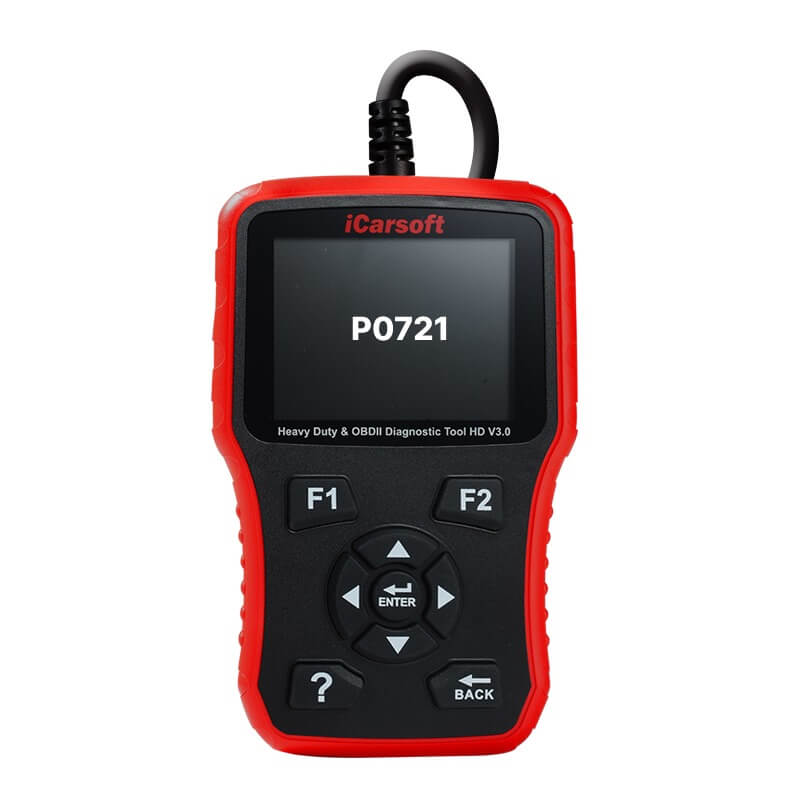P0721 – Output Speed Sensor Range/Performance
POSTED IN pcodes
Welcome to our article on the P0721 diagnostic trouble code. In this section, we will discuss the range/performance issue with the output speed sensor (OSS) in the transmission control module (TCM). The output speed sensor plays a crucial role in monitoring the speed of the output shaft in the transmission, ensuring smooth shifting and torque converter engagement. When the TCM detects a malfunction in the OSS circuit, it triggers the P0721 code.
Experiencing a performance issue with your vehicle’s sensor can be frustrating, but understanding the P0721 code is the first step towards resolving the problem. Symptoms of this code may include a malfunction indicator lamp (MIL) or check engine light, incorrect speedometer reading, delayed or rough shifting, engine stalling, and misfiring. It is crucial to address the P0721 code promptly to avoid potential performance issues and further damage to your vehicle.
Key Takeaways:
- The P0721 code indicates a range/performance issue with the output speed sensor (OSS) in the transmission control module (TCM).
- The OSS monitors the speed of the output shaft in the transmission for proper shifting and torque converter engagement.
- Symptoms of the P0721 code include a malfunction indicator lamp (MIL) or check engine light, incorrect speedometer reading, delayed or rough shifting, and engine stalling.
- Possible causes of the P0721 code include a faulty output speed sensor, damaged wiring harness, loose connections, or issues with the transmission fluid temperature (TFT) sensor.
- Diagnosing and repairing the P0721 code may involve inspecting the OSS for damage, testing its resistance, checking the wiring for any damage or loose connections, and ensuring proper power supply to the sensor and the TCM.
P0721 Code Definition and Meaning
The P0721 code is a generic powertrain code that indicates a range/performance issue with the output shaft speed sensor (OSS) in the transmission control module (TCM). The OSS is responsible for monitoring the speed of the output shaft in the transmission and providing this information to the TCM for proper shifting and torque converter engagement. When the TCM detects a malfunction in the OSS circuit, it triggers the P0721 code.
This code can be triggered by a faulty OSS, damaged wiring, loose connections, or issues with the transmission fluid temperature (TFT) sensor. Symptoms of the P0721 code may include a malfunction indicator lamp (MIL) or check engine light, incorrect speedometer reading, delayed or rough shifting, engine stalling, misfires, and poor fuel economy.
Diagnosing the P0721 code involves inspecting the OSS for damage, testing its resistance, checking the wiring and connections for any damage or corrosion, and ensuring the proper power supply to the sensor and the TCM. Repairs for this code may include replacing the faulty sensor, repairing or replacing damaged wiring or connectors, addressing any issues with the transmission or TFT sensor, or flushing the transmission fluid if it is contaminated.
Buy tested tuning file for Adblue / EGR / DPF / Adblue off now!
Promptly addressing the P0721 code is important to prevent potential performance issues and further damage to the vehicle.

Key Points:
- The P0721 code indicates a range/performance issue with the output shaft speed sensor (OSS) in the transmission control module (TCM).
- Symptoms of the P0721 code may include a malfunction indicator lamp (MIL) or check engine light, incorrect speedometer reading, delayed or rough shifting, engine stalling, misfires, and poor fuel economy.
- Diagnosing and repairing the P0721 code involves inspecting the OSS for damage, testing its resistance, checking the wiring and connections, and ensuring the proper power supply to the sensor and the TCM.
- Addressing the P0721 code promptly is important to prevent potential performance issues and further damage to the vehicle.
Symptoms and Common Causes of the P0721 Code
The P0721 code can manifest in various symptoms, indicating a potential issue with the output speed sensor (OSS) and leading to performance problems in your vehicle. Common signs of the P0721 code include:
- A malfunction indicator lamp (MIL) or check engine light illuminated on the dashboard
- Incorrect speedometer readings, displaying inaccurate speed information
- Delayed or rough shifting, experiencing difficulty in changing gears smoothly
- Engine stalling, where the engine unexpectedly shuts off while driving or at idle
- Misfires, characterized by a loss of power, rough engine operation, or unusual vibrations
- Poor fuel economy, noticing a decrease in your average mileage per gallon
- Possible activation of the engine’s “limp mode,” limiting performance to protect the drivetrain
Identifying the underlying causes of the P0721 code is essential for effective repairs. The following are common culprits contributing to this diagnostic trouble code:
- Faulty output speed sensor (OSS): A malfunctioning OSS can result in improper speed readings and disrupt the transmission control module’s (TCM) ability to regulate shifting.
- Dirty or contaminated transmission fluid: Contaminated fluid can hinder the OSS’s ability to accurately measure speed, leading to code P0721.
- Dirty or clogged transmission filter: A clogged filter can restrict fluid flow, affecting the performance of the OSS and triggering the P0721 code.
- Defective coolant temperature sensor: An issue with the coolant temperature sensor can disrupt the OSS’s operation, causing the code to appear.
- Defective transmission valve body: A faulty valve body can disrupt the smooth flow of transmission fluid, resulting in inaccurate speed readings and the activation of code P0721.
- Restricted hydraulic passages: Obstructions in the hydraulic passages can impede fluid flow, affecting the OSS’s functionality and leading to the code.
- Faulty shift solenoid: A malfunctioning solenoid can disrupt the proper operation of the transmission, potentially triggering the P0721 code.
- Corroded or damaged connectors: Poor connections due to corrosion or physical damage can interfere with the signal transmission between the OSS and TCM.
- Faulty or damaged wiring: Damaged or broken wires can disrupt the electrical signals between the OSS and TCM, contributing to the appearance of the code.
- Faulty powertrain control module (PCM): In some cases, a faulty PCM can inaccurately interpret the OSS’s inputs, leading to the code’s activation.
Proper diagnosis and inspection are necessary to pinpoint the specific cause of the P0721 code in your vehicle and undertake the appropriate repairs.
Diagnosing and Repairing the P0721 Code
Diagnosing the P0721 code requires a systematic approach to identify the source of the issue. Mechanics typically follow a series of steps to ensure an accurate diagnosis and effective repairs.
1. Inspection of Output Speed Sensor
The first step involves removing the output speed sensor (OSS) and carefully examining it for any signs of damage or wear. Missing or worn teeth on the sensor can indicate a fault.
2. Resistance Testing
Next, the mechanic will test the resistance of the OSS using a multimeter. This test helps determine if the sensor’s electrical resistance falls within the acceptable range. Abnormal resistance readings can indicate a faulty sensor.
3. Wiring Harness Inspection
Inspecting the wiring harness is crucial to identify any damage or loose connections. The mechanic will visually examine the wiring, looking for signs of fraying, corrosion, or breaks. Clean terminals ensure proper electrical contact.
4. Transmission Fluid Temperature (TFT) Sensor Check
In vehicles equipped with a TFT sensor inline with the OSS sensor, mechanics should check the resistance of the TFT sensor. This test ensures the proper functioning of both sensors.
Note: Common mistakes during the diagnosis process include misdiagnosing the P0721 code as an engine/turbine speed problem, an internal transmission issue, or fuel delivery problems. These errors can lead to unnecessary replacement of the output speed sensor.
Once the diagnostic process is complete, appropriate repairs can be made to address the root cause of the P0721 code. Common repairs include:
- Replacing the faulty output speed sensor (OSS)
- Repairing or replacing damaged wiring or connectors
- Checking the power supply to the OSS and the transmission control module (TCM)
- Addressing any issues with the TFT sensor
| Repair Steps | Description |
|---|---|
| Replacing the faulty output speed sensor (OSS) | This involves removing the faulty OSS and installing a new sensor in its place. It is essential to choose a high-quality replacement to ensure proper functionality. |
| Repairing or replacing damaged wiring or connectors | If the wiring harness or connectors are damaged, repairs or replacements may be necessary. Ensuring secure connections and intact wiring is crucial for accurate sensor readings. |
| Checking the power supply to the OSS and TCM | Inspecting the power supply to both the output speed sensor and the transmission control module is crucial to diagnose any electrical issues. If a power supply problem is detected, it should be resolved and the system tested. |
| Addressing any issues with the TFT sensor | If present, the transmission fluid temperature (TFT) sensor should be checked for proper resistance and functionality. If any issues are detected, appropriate repairs or replacements should be made. |
Conclusion
The P0721 code is a diagnostic trouble code that indicates a range/performance issue with the output speed sensor (OSS) in the transmission control module (TCM). This code can cause symptoms such as a malfunction indicator lamp (MIL) or check engine light, incorrect speedometer reading, delayed or rough shifting, engine stalling, misfires, and poor fuel economy. To diagnose and repair the P0721 code, it is important to inspect the OSS for damage, test its resistance, check the wiring and connections, and ensure proper power supply to the sensor and the TCM.
Common causes of the P0721 code include a faulty OSS, dirty or contaminated transmission fluid, a dirty or clogged transmission filter, a defective coolant temperature sensor, a defective transmission valve body, restricted hydraulic passages, a faulty shift solenoid, corroded or damaged connectors, faulty or damaged wiring, or a faulty powertrain control module (PCM). Addressing the P0721 code promptly is crucial to prevent potential performance issues and further damage to the vehicle.
Repairs for the P0721 code may involve replacing the faulty OSS sensor, repairing or replacing damaged wiring or connectors, addressing issues with the transmission fluid temperature (TFT) sensor, or flushing the transmission fluid if it is contaminated. If professional assistance is not available, alternative solutions such as uploading the Engine Control Unit (ECU) file to a portal for permanent removal of the code can be considered. Remember, proper diagnosis and repair of the P0721 code are essential for the proper functioning of the transmission and overall vehicle performance.
FAQ
What does the P0721 code mean?
The P0721 code is a diagnostic trouble code that indicates a range/performance issue with the output speed sensor in the transmission control module.
What is the function of the output speed sensor?
The output speed sensor (OSS) is responsible for monitoring the speed of the output shaft in the transmission and providing this information to the transmission control module.
What are the symptoms of the P0721 code?
Symptoms of the P0721 code include a malfunction indicator lamp or check engine light, incorrect speedometer reading, delayed or rough shifting, engine stalling, and misfiring.
What are the common causes of the P0721 code?
The P0721 code can be caused by a faulty output speed sensor, damaged wiring harness, loose connections, or issues with the transmission fluid temperature sensor.
How is the P0721 code diagnosed and repaired?
Diagnosing the P0721 code involves inspecting the output speed sensor for damage, testing its resistance, checking the wiring for any damage or loose connections, and ensuring proper power supply to the sensor and the transmission control module. Repairs may include replacing the faulty sensor, repairing or replacing damaged wiring or connectors, and addressing any underlying issues with the transmission or fluid temperature sensor.


